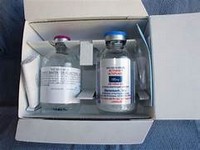Alteplase
CLINICAL USE
Fibrinolytic drug:
DOSE IN NORMAL RENAL FUNCTION
IV bolus, 50 mg over 30 minutes, then
35 mg over 1 hour (total dose 100 mg); or
(if initiated within 6–12 hours) 10 mg over
1–2 minutes followed by IV infusion of
50 mg over 1 hour, then 4 infusions each
of 10 mg over 30 minutes (total dose –
100 mg over 3 hours)
infusion of 90 mg over 2 hours. Total dose
should not exceed 1.5 mg/kg in patients
who weigh <65 kg
60 minutes, 10% of dose as initial bolus;
maximum 90 mg. Start within 3 hours of
symptoms
PHARMACOKINETICS
65 000 (non-
glycosylated protein)
No data
Minimal
0.1
α: 4–5 minutes; β:
40 minutes
DOSE IN RENAL IMPAIRMENT
GFR (mL/MIN)
Dose as in normal renal function
DOSE IN PATIENTS UNDERGOING RENAL REPLACEMENT THERAPIES
Not dialysed. Dose as in normal renal function
Not dialysed. Dose as in normal renal function
Unknown dialysability. Dose as in
normal renal function
Not dialysed. Dose as in normal renal function
IMPORTANT DRUG INTERACTIONS
Potentially hazardous interactions with other drugs
aggregation inhibitors, heparin, and other
agents influencing coagulation
ADMINISTRATION
Reconstition
20 mg vial: dissolve in
The reconstituted solutions can be further
diluted (minimum concentration 0.2 mg/
mL) with sterile sodium chloride 0.9%
Route
IV
Rate of Administration
See under dose
Comments
OTHER INFORMATION
to dose schedule
administration is possible
hyperkalaemia in renal failure
least 60 minutes or until the next dialysis
session
20 hours, or 50 mg over 12 hours
